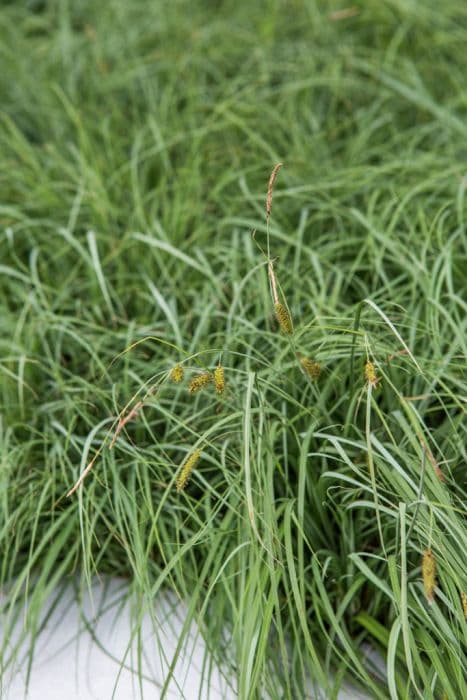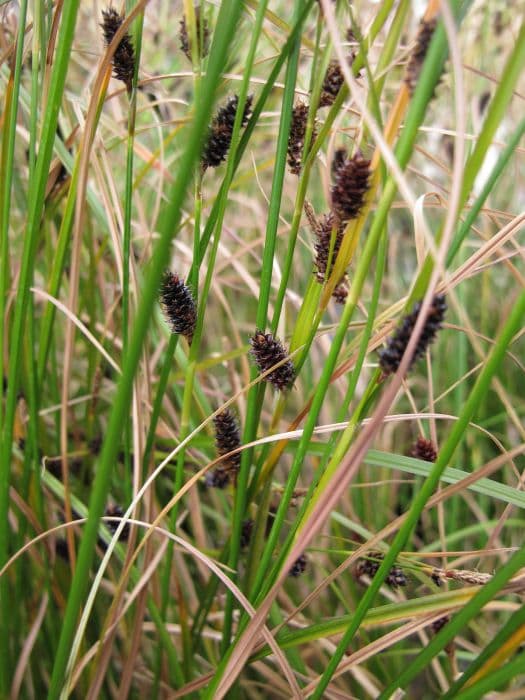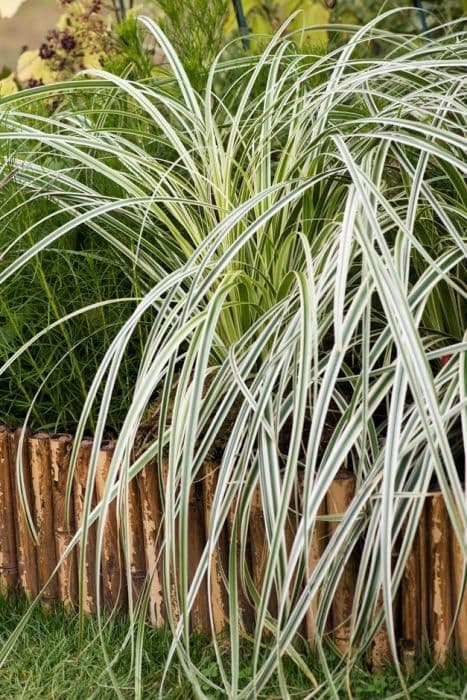Greater Pond Sedge Carex riparia











ABOUT
The plant in question, commonly known as the Great Pond Sedge, has a robust and striking appearance characterized by its lush, green foliage. The leaves are typically long, narrow and arching with a slightly rough texture, giving the plant a dense, grass-like look. Each leaf culminates in a tapering point and often features a distinct central ridge or keel, which can be felt when running fingers along the leaf. The Great Pond Sedge is also notable for its flower spikes, which emerge on stalks rising from within the clump of foliage. These spikes possess a green to brownish color and are segmented, resembling a series of small, densely-packed pouches arranged along the stem. After flowering, the plant forms seed heads that can add a textural element to its appearance. Furthermore, this sedge's root system is composed of rhizomes, which are underground stems that allow it to spread and form dense colonies. This growth habit contributes to its use in stabilizing soil near bodies of water or in wetland areas. The overall impression of the Great Pond Sedge is one of a sturdy, vital plant that can impart a natural, wild aspect to the landscape in which it thrives.
About this plant
 Names
NamesFamily
Cyperaceae
Synonyms
Greater Pond Sedge, Bank Sedge
Common names
Carex acutiformis Ehrh., Carex paludosa Gooden., Vignea riparia (Curtis) Rchb., Carex riparia var. jemtlandica (Fr.) Liro, Carex jemtlandica Fr., Carex austro-riparia Kalela, Carex pseudocyperus var. riparia (Curtis) Syme, Carex elongata var. riparia (Curtis) Hartman, Trasus riparius (Curtis) Gray
 Toxicity
ToxicityTo humans
Carex riparia, commonly known as Greater Pond Sedge, is not widely recognized for its toxicity to humans. There is limited information suggesting harmful effects from ingesting Greater Pond Sedge. However, as with many plants, individuals may have varying sensitivities, and it is generally advisable to avoid eating plants that are not identified as safe for consumption. If Greater Pond Sedge is found to be toxic, typical symptoms of plant poisoning might include gastrointestinal distress such as nausea, vomiting, or diarrhea, but specific symptoms resulting from ingestion of this plant have not been well-documented.
To pets
Greater Pond Sedge is not commonly reported to be toxic to pets. However, as with any plant, individual animals may have unique sensitivities, and ingestion of non-food plants can sometimes lead to gastrointestinal upset or other issues. If Greater Pond Sedge were toxic to pets, symptoms could potentially mirror those of plant poisonings generally, including vomiting, diarrhea, or abdominal discomfort. There is no widespread documentation of Greater Pond Sedge causing significant toxicity in pets, yet it is always prudent to prevent pets from consuming plants that are not verified as safe.
 Characteristics
CharacteristicsLife cycle
Perennials
Foliage type
Semi-evergreen
Color of leaves
Green
Flower color
Brown
Height
2-4 feet (0.6-1.2 meters)
Spread
2-3 feet (0.6-0.9 meters)
Plant type
Herb
Hardiness zones
5
Native area
Europe
Benefits
 General Benefits
General Benefits- Erosion Control: Carex riparia has an extensive root system that helps stabilize soil and prevent erosion along riverbanks and waterways.
- Wildlife Habitat: It offers shelter and nesting materials for birds and small mammals, and serves as a habitat for aquatic insects.
- Water Filtration: It plays a role in filtering pollutants and improving water quality in wetland ecosystems.
- Aesthetic Value: Greater pond sedge has an attractive appearance for naturalistic landscaping and garden designs.
- Biodiversity Support: As a native species to certain regions, it helps maintain local biodiversity by providing food and habitat for various species.
- Adaptability: It is well-suited to wet and damp conditions, making it ideal for planting in challenging moist areas where other plants may struggle.
- Low Maintenance: Once established, it requires minimal care, making it a low-maintenance option for landscaping.
 Medical Properties
Medical Properties- Historically, Carex species have been used in traditional medicine for treating wounds thanks to their antimicrobial properties.
- Some Carex species have been researched for their anti-inflammatory compounds, which might be used in treating conditions associated with inflammation.
 Air-purifying Qualities
Air-purifying QualitiesThis plant is not specifically known for air purifying qualities.
 Other Uses
Other Uses- Carex riparia, also known as greater pond sedge, can be woven into baskets and mats due to its long, strong leaves.
- The robust stems of the greater pond sedge make it suitable for crafting garden stakes and supporting other plants.
- These sedges can be used in land reclamation projects to stabilize soil and prevent erosion in marshy areas.
- Greater pond sedge is planted in constructed wetlands for wastewater treatment, where it helps remove contaminants from the water.
- The seeds of Carex riparia can be a food source for wildlife, particularly for some bird species.
- Gardeners may use the dried foliage of greater pond sedge as a natural mulch to suppress weeds and retain soil moisture.
- Greater pond sedge can be integrated into livestock grazing systems, serving as fodder in wetter pasture areas.
- This plant, being robust and dense, is utilized in creating living screens or barriers for privacy in gardens and parks.
- Its attractive form makes greater pond sedge a choice plant for ornamental use in water gardens and pond edges.
- Greater pond sedge can be a component in biomonitoring studies as an indicator of water quality and ecosystem health.
Interesting Facts
 Feng Shui
Feng ShuiThe Carex riparia, commonly known as Greater Pond Sedge, is not used in Feng Shui practice.
 Zodiac Sign Compitability
Zodiac Sign CompitabilityGreater Pond Sedge is not used in astrology practice.
 Plant Symbolism
Plant Symbolism- Adaptability: Carex riparia, commonly known as Greater Pond Sedge, thrives in wetlands and riparian zones, symbolizing the ability to adapt to varying environments and conditions.
- Protective Nature: As it often forms dense clumps, this plant can symbolize a protective barrier, analogous to how it stabilizes riverbanks and prevents erosion in its natural habitat.
- Resilience: Greater Pond Sedge demonstrates a robust nature by withstanding periods of flooding and waterlogging, representing resilience and the capacity to recover from difficult situations.
- Purification: Given its role in natural water filtration and habitat purification in ecosystems, Carex riparia can symbolize cleansing and the removal of negativity or impurities from one's life.
 Water
WaterThe Greater Pond Sedge should be kept consistently moist, benefitting from watering about twice a week or enough to keep the soil from drying out. In terms of water volume, providing around a half to one gallon of water per week should suffice, depending on weather conditions and soil drainage. During periods of high heat or drought, you may need to increase the frequency of watering. Conversely, reduce the amount and frequency during cooler, wet months to prevent waterlogging.
 Light
LightGreater Pond Sedge thrives best in full sun to partial shade conditions. However, it is adaptable and can tolerate a range of light levels. The ideal spot for this plant would be where it receives morning sunlight and afternoon shade, or dappled sunlight throughout the day.
 Temperature
TemperatureGreater Pond Sedge is hardy and can survive in temperatures as low as -20°F and as high as around 100°F. The ideal temperature for this plant is between 50°F and 70°F. Extreme temperatures outside the mentioned range might damage or stress the plant.
 Pruning
PruningPruning the Greater Pond Sedge is not strictly necessary, but it can be beneficial to maintain its shape and encourage new growth. Trim any dead or damaged leaves in the spring to tidy up the plant and stimulate fresh growth. Typically, this is done annually at the end of winter or the very early spring before new growth begins.
 Cleaning
CleaningNot needed
 Soil
SoilGreater Pond Sedge thrives in a soil mix that is rich in organic matter, moist, and well-draining with a pH of 5.5 to 7.0. A blend consisting of peat, loamy soil, and sand can provide an optimal growing medium. Regularly check the soil moisture to ensure it's consistently damp but not waterlogged.
 Repotting
RepottingThe Greater Pond Sedge should be repotted every 2-3 years to prevent it from becoming root-bound and to replenish its soil. Early spring is the best time for repotting, allowing the plant to establish in its new container before the growing season.
 Humidity & Misting
Humidity & MistingGreater Pond Sedge prefers high humidity levels, typically above 60%. This plant is naturally found in wetlands, so it thrives in environments that can emulate these moisture-rich conditions without direct watering of the foliage.
 Suitable locations
Suitable locationsIndoor
Use moist well-draining soil; place in bright, indirect light.
Outdoor
Plant in wet ground, full sun to partial shade.
Hardiness zone
4-8 USDA
 Life cycle
Life cycleCarex riparia, commonly known as Greater Pond Sedge, begins its life cycle as a seed, which upon germination in suitable wetland conditions, develops into a seedling. The seedling grows into a clump-forming perennial plant with a dense root system and an extensive network of rhizomes, which allow it to spread and colonize the area. It develops long, narrow leaves and in spring to early summer, it produces flowering spikes with separate male and female flowers that are wind-pollinated. After pollination, the plant produces fruits in the form of small, brown, one-seeded utricles. These seeds are dispersed by water or animals, enabling the plant to propagate and start a new cycle. Over winter, the above-ground parts may die back, but the plant remains dormant and will regrow from its perennial rootstock with the return of favorable conditions in the spring.
 Propogation
PropogationPropogation time
Spring-Early Summer
The most popular method of propagation for Greater Pond Sedge (Carex riparia) is by division. This is typically done in late winter or early spring before new growth begins. To propagate by division, one should carefully lift the parent plant from the ground using a spade or fork, ensuring as much of the root system is intact as possible. The clump should then be gently teased apart into smaller sections, each with a portion of roots and several shoots. These sections can be replanted immediately at the same depth they were growing at originally, spaced about 18 inches (approximately 45 centimeters) apart to allow room for growth. The soil should be kept moist until the new plants are established. This method is effective for expanding Carex riparia in the landscape or for sharing with fellow gardeners.



![Japanese sedge [Everest]](/_next/image?url=https%3A%2F%2Fplants-admin.emdemapps.com%2Fimages%2Fplants%2F%2Fimages%2F604b5b6de0548.png&w=640&q=75)





